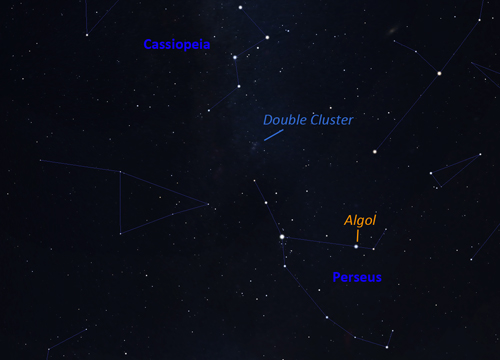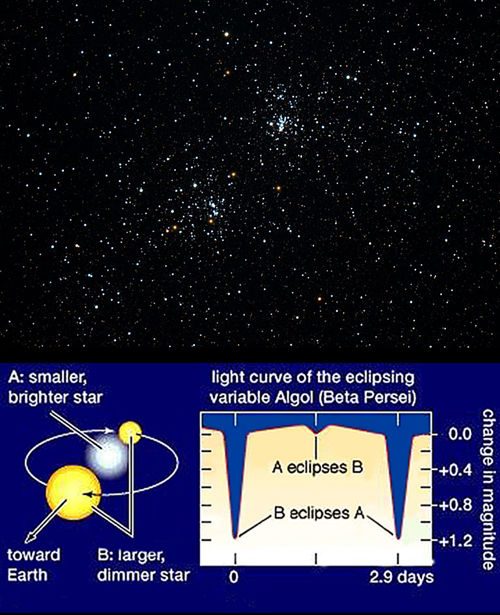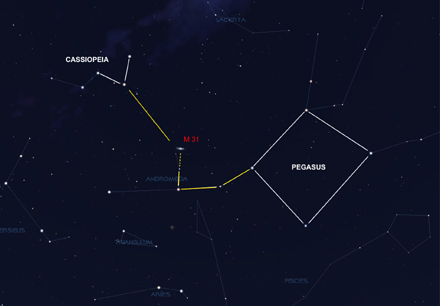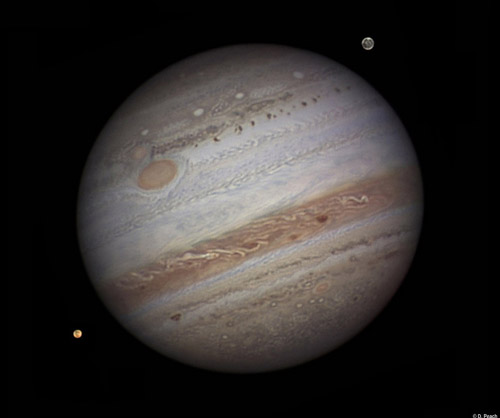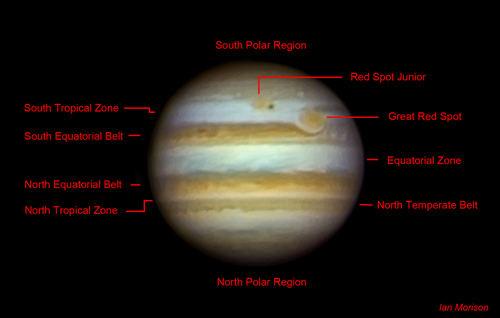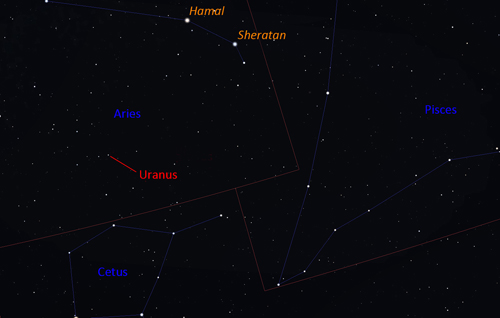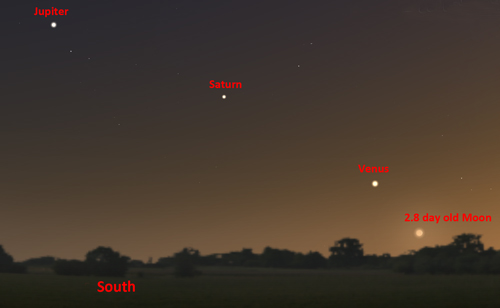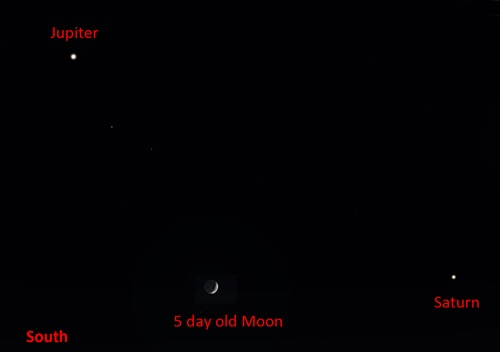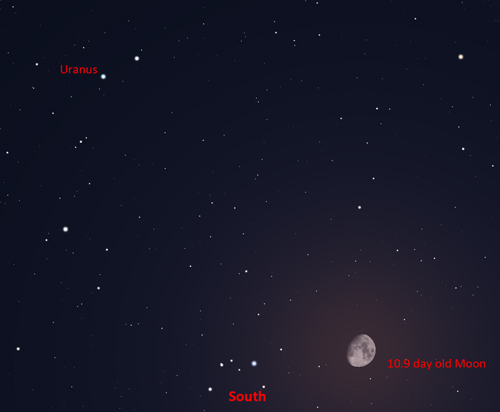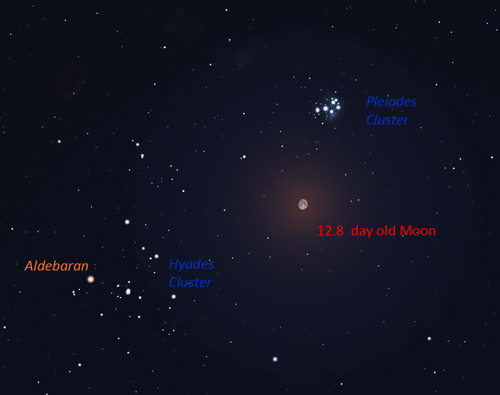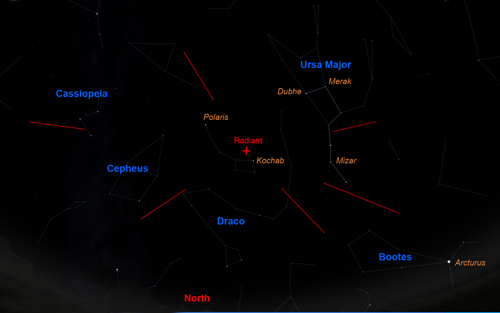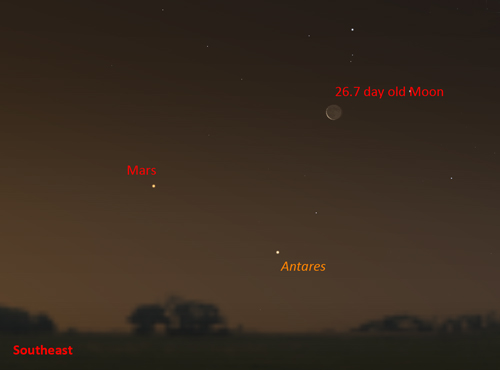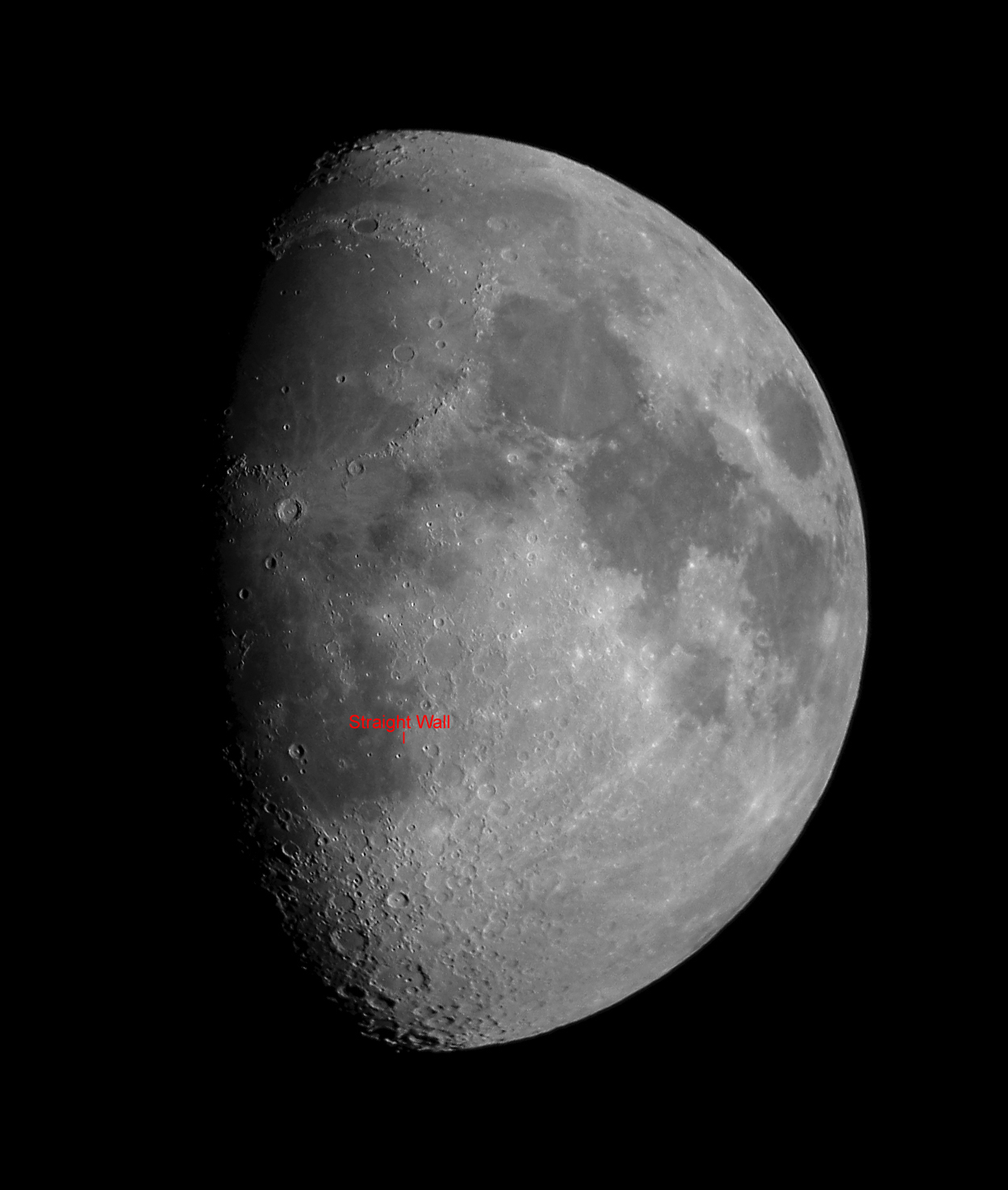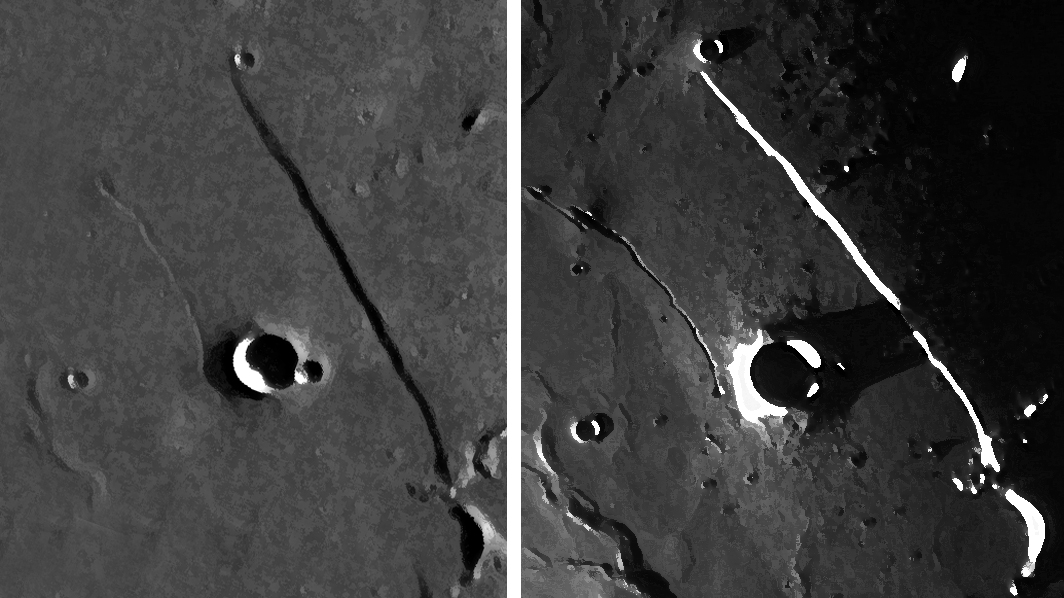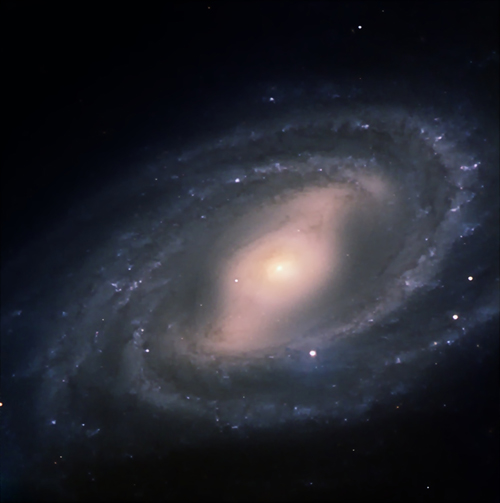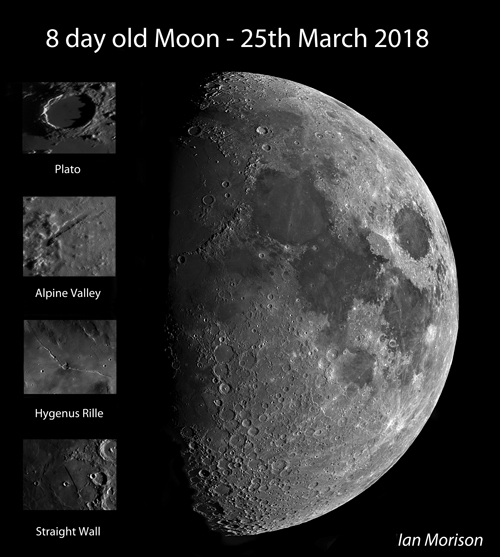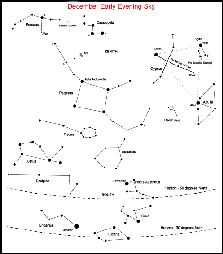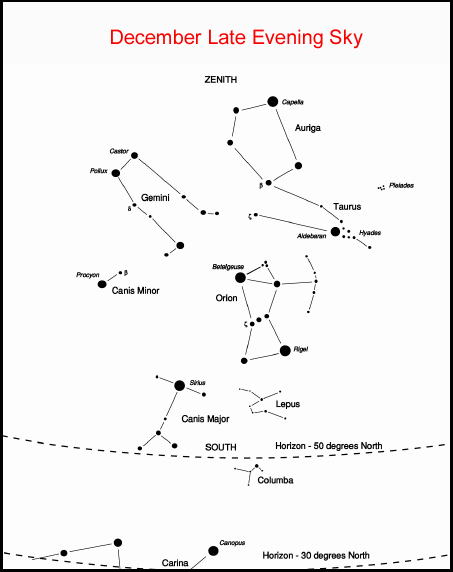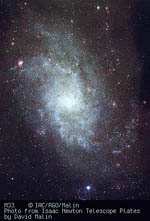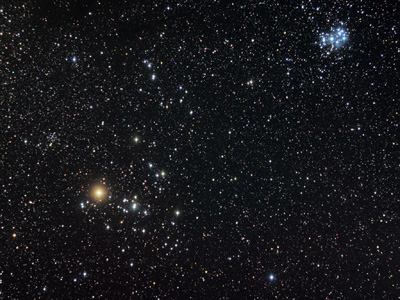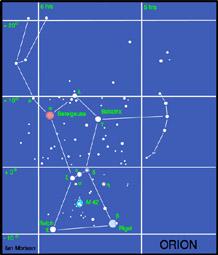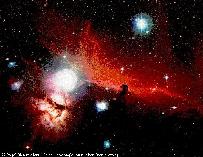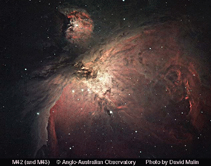Monthly Night Sky Guide December 2021
Compiled by Ian Morison
This page, updated monthly, will let you know some of the things that you can look out for in the night sky. It lists the phases of the Moon, where you will see the naked-eye planets and describes some of the prominent constellations in the night sky during the month.
New(ish)
The author's: Astronomy Digest
which, over time, will provide useful and, I hope, interesting articles for all amateur astronomers. A further aim is to update and add new material to link with the books recently published by Cambridge University Press and which are described on the home page of the digest. It now includes over 100 illustrated articles.Image of the Month
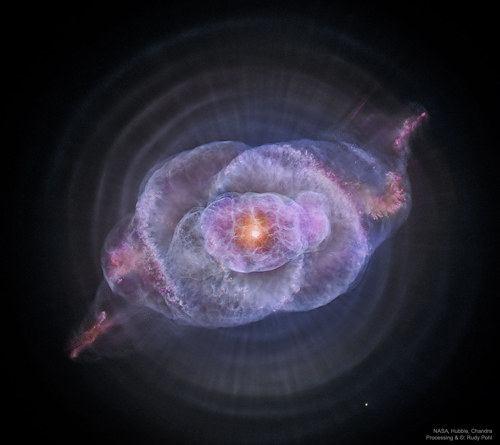
This, most beautiful image of the Cat's Eye Planetary Nebula, is a combination of data from the Hubble Space Telescope and the Chandra X-ray Observatory. It is composed of gas ejected from a sun-like star at the end of its life which surrounds the 'White Dwarf' remnent of the star's fusion core. It spans around half a light year across and the outer rings were formed in a series of convulsions as the star ended its life.
Highlights of the Month
December, evening: the Double Cluster and the 'Demon Star', Algol.
This month is a good time to look high in the southeast towards the constellations of Cassiopea and Perseus. Perseus contains two interesting objects; the Double Cluster between the two constellations and Algol the 'Demon Star'. Algol in an eclipsing binary system as seen in the diagram below. Normally the pair has a steady magnitude of 2.2 but every 2.86 days this briefly drops to magnitude 3.4.
December: find M31 - The Andromeda Galaxy - and perhaps M33 in Triangulum
In the late evenings when the Moon is not prominent, the galaxy M31 in Andromeda will be visible high in the southeast. The chart provides two ways of finding it:
1) Find the square of Pegasus. Start at the top left star of the square - Alpha Andromedae - and move two stars to the left and up a bit. Then turn 90 degrees to the right, move up to one reasonably bright star and continue a similar distance in the same direction. You should easily spot M31 with binoculars and, if there is a dark sky, you can even see it with your unaided eye. The photons that are falling on your retina left Andromeda well over two million years ago!
2) You can also find M31 by following the "arrow" made by the three rightmost bright stars of Cassiopeia down to the lower right as shown on the chart.
Around new Moon (3rd December) - and away from towns and cities - you may also be able to spot M33, the third largest galaxy after M31 and our own galaxy in our Local Group of galaxies. It is a face on spiral and its surface brightness is pretty low so a dark, transparent sky will be needed to spot it using binoculars (8x40 or, preferably, 10x50). Follow the two stars back from M31 and continue in the same direction sweeping slowly as you go. It looks like a piece of tissue paper stuck on the sky just a bit brighter than the sky background. Good Hunting!
December - still worth observingJupiter.
This is still not a bad month to observe Jupiter which will be visible in the south after sunset. It lies in the southern part of the ecliptic and, sadly, will only reach an elevations of ~22 degrees when crossing the meridian. An interesting observation is that the Great Red Spot appears to be diminishing in size. At the beginning of the last century it spanned 40,000 km across but now appears to be only ~16,500 km across - less than half the size. It used to be said that 3 Earths could fit within it, but now it is only one. The shrinking rate appears to be accelerating and observations indicate that it is now reducing in size by ~580 miles per year. Will it eventually disappear?
The features seen in the Jovian atmosphere have been changing quite significantly over the last few years - for a while the South Equatorial Belt vanished completely (as seen in Damian's image) but has now returned to its normal wide state. The diagram on right shows the main Jovian features as imaged by the author at the beginning of December 2012. The image by Damian Peach was taken with a 14 inch telescope in Barbados where the seeing can be particularly good. This image won the "Astronomy Photographer of the Year" competition in 2011.See more of Damian Peach's images: Damian Peaches Website"
December: find Uranus.
This month is a still a good time to find the planet Uranus in the late evening as it reached opposition on November 4th. With a magnitude of 5.7, binoculars will easily spot it and, from a really dark site, it might even be visible to the unaided eye. A medium aperture telescope will reveal Uranus's 3.7 arc second wide disk showing its turquoise colour. It lies in Aries, close to the boarder of Cetus as shown on the chart. A highlight below shows when it lies just above the Moon so making it easy to find.
December 6th - after sunset: Three planets and a crescent Moon
If clear after sunset on the 6th, there will be lovely line up of Jupiter, Saturn and Venus along with a very thin crescent Moon. Binoculars may well be needed to cut through the Sun's glare, but please do not use them until after the Sun has set.
December 8th after sunset: - Jupiter, Saturn and the Moon
If clear after sunset on the 6th, one could observe the Moon lying below Jupiter and Saturn.
December 14th - evening: - Uranus above the Moon
If clear in the evening of the 14th, Uranus could be spotted lying up to the left of the Moon.
December 16th - late evening: the Moon below the Hyades and Pleiades Clusters
If clear in the late evening of the 16th, the Moon will be seen to lie just below the Hyades and Pleiades clusters.
December 22nd/23rd - late evenings: the Ursid Meteor Shower
The late evenings of the 22nd and 23rd of December are when the Ursid meteor shower will be at its best - though the peak rate of ~10-15 meteors per hour is not that great. This year, the Moon will be moving towards third quarter so, sadly, its light will hinder our view. The radiant lies close to the star Kochab in Ursa Minor (hence their name), so look northwards at a high elevation. Occasionally, there can be a far higher rate so it's worth having a look should it be clear.December 31st - before dawn: Mars and the Moon
If clear and given a low horizon towards the southeast, Mars should be visible down to the left of a very thin waning crescent Moon.December - Evenings of the 12th and 26th: The Straight Wall
The Straight Wall
The Straight Wall, or Rupes Recta, is best observed either 1 or 2 days after First Quarter or a day or so before Third Quarter. To be honest, it is not really a wall but a gentle scarp - as Sir Patrick has said "Neither is it a wall nor is it straight!"
M109 imaged with the Faulkes Telescope
The Galaxy M109, imaged by Daniel Duggan.
This image was taken using the Faulkes Telescope North by Daniel Duggan - for some time a member of the Faulkes telescope team. It shows the barred spiral galaxy M109 that lies at a distance of 83 million light years in the constellation of Ursa Major. It is the brightest galaxy in the Ursa Major group of some 50 galaxies. Our own Milky Way galaxy is now thought to be a barred spiral like M109.
Learn more about the Faulkes Telescopes and how schools can use them: Faulkes Telescope"
The Moon

The Moon at 3rd Quarter. Image, by Ian Morison, taken with a 150mm Maksutov-Newtonian and Canon G7.
Just below the crator Plato seen near the top of the image is the mountain "Mons Piton". It casts a long shadow across the maria from which one can calculate its height - about 6800ft or 2250m.
| new moon | first quarter | full moon | third quarter |
|---|---|---|---|
| December 3rd | December 10th | December 18th | December 26th |
Some Lunar Images by Ian Morison, Jodrell Bank Observatory: Lunar Images
A World Record Lunar Image
To mark International Year of Astronomy, a team of British astronomers have made the largest lunar image in history and gained a place in the Guinness Book of Records! The whole image comprises 87.4 megapixels with a Moon diameter of 9,550 pixels. The resolution of ~0.4 arc seconds allows details as small as 1km across to be discerned! The superb quality of the image is shown by the detail below of Plato and the Alpine Valley. Craterlets are seen on the floor of Plato and the rille along the centre of the Alpine valley is clearly visible. The image quality is staggering! The team of Damian Peach, Pete lawrence, Dave Tyler, Bruce Kingsley, Nick Smith, Nick Howes, Trevor Little, David Mason, Mark and Lee Irvine with technical support from Ninian Boyle captured the video sequences from which 288 individual mozaic panes were produced. These were then stitched together to form the lunar image.
Please follow the link to the Lunar World Record website and it would be really great if you could donate to Sir Patrick Moore's chosen charity to either download a full resolution image or purchase a print.
The 8 day old Moon
This image was taken by the author on a night in March 2018 when the Moon was at an elevation of ~52 degrees and the seeing was excellent. This enabled the resolution of the image to be largely determined by the resolution of the 200 mm aperture telescope and the 3.75 micron pixel size of the Point Grey Chameleon 1.3 megapixel video camera. The use of a near infrared filter allowed imaging to take place before it was dark and also reduced the effects of atmospheric turbulence. The 'Drizzle' technique developed by the Hubble Space Telescope Institute (HSTI) was used to reduce the effective size of the camera's pixels to allow the image to be well sampled. Around 100 gigabytes of data, acquired over a 2 hour period, was processed to produce images of 54 overlapping areas of the Moon which were then combined to give the full lunar disk in the free 'stitching' program Microsoft ICE. A further HSTI development called 'deconvolution sharpening' was then applied to the image. The Moon's disk is ~6,900 pixels in height and has a resolution of 0.6 to 0.7 arc seconds. Interestingly, as seen in the inset image, the rille lying along the centre of the Alpine Valley is just discernable and this is only ~0.5 km wide! [Due to size limitations the large image is 2/3 full size.]
The Planets
Jupiter
Jupiter. As darkness falls at the start of December, Jupiter, having a magnitude of -2.29 and an angular size of 38.3 arc seconds, may be seen in the south. It transits at 17:15 GMT with an elevation of ~24 degrees. By month's end its magnitude will have reduced slightly to -2.13 and its angular size to 35.36 arc seconds and it will be seen in the south southwest at nightfall. Happily, this year Jupiter has climbed up the ecliptic somewhat so the atmosphere will not hinder our view of the solar system's giant planet as much as it has in the last two years.
Saturn
Saturn precedes Jupiter into the sky and will be seen towards the south southwest at nightfall. It then shines with a magnitude of +0.7 with its disk 16 arc seconds across and the rings spanning some 37 arc seconds. By month's end, it has a reduced brightness of magnitude +0.71 with a 15.46 arc second disk. Sadly, its elevation will only be about 17 degrees as December begins so the atmosphere will hinder our view of this most beautiful planet.
Mercury
Mercury. Mercury, having passed behind the Sun at the beginning of December, makes an appearence after sunset in the last few days of the month very low in the southwest below Venus. It will have a magnitude of ~-0.73 and an angular size of ~6 arc seconds. Binoculars may well be needed to spot it, but please do not use them until after the Sun has set.
Mars
This month, Mars climbs out of the Sun's glare in the pre-dawn sky having a magnitude of 1.64 on the first with an angular size of 3.77 arc seconds. It will then be best seen at around 06:41 GMT in the southeast. By month's end the best time to observe it will be at ~07:00 GMT when it magnitude will have increased slightly to 1.54 with an angular size of 4 degrees. Binoculars may well be needed, but please do not use them after the Sun has risen.
Venus
Venus. At the start of December, Venus, at magnitude -4.87 and having an angular size of ~39 arc seconds, will only have an elevation of ~8 degrees at sunset looking towards the south southwest. It may well not be visible until around 16:00. During the month it falls back towards the Sun and will be lost in the Sun's glare. As the ecliptic is at a shallow angle to the horizon in the latter part of the year, it has never got to a high evening elevation during this apparation.
The Stars
The Early Evening December Sky
The Late Evening December Sky
The maps shows the constellations seen towards the south in the early and late evening. Setting towards the west in early evening is the beautiful region of the Milky Way containing both Cygnus and Lyra. Below is Aquilla. The three bright stars Deneb (in Cygnus), Vega (in Lyra) and Altair (in Aquila) make up the "Summer Triangle". East of Cygnus is the great square of Pegasus - adjacent to Andromeda in which lies M31, the Andromeda Nebula. To the north lies "w" shaped Cassiopeia and Perseus. The map shows the constellation Taurus, with its two lovely clusters, the Hyades and the Pleaides, and is also described in more detail below. As the evening draws on, Orion, the Hunter, follows Taurus into the eastern sky with the constellations Auriga, above, and Gemini, to the upper left. Later Sirius, in Canis Major will be seen to the lower left of Orion. Due to its brightness and scintillations caused by the atmosphere it often appears as a rainbow of colours flashing in the sky.
The constellations Pegasus and Andromeda
Pegasus
The Square of Pegasus is in the south during the evening and forms the body of the winged horse. The square is marked by 4 stars of 2nd and 3rd magnitude, with the top left hand one actually forming part of the constellation Andromeda. The sides of the square are almost 15 degrees across, about the width of a clentched fist, but it contains few stars visibe to the naked eye. If you can see 5 then you know that the sky is both dark and transparent! Three stars drop down to the right of the bottom right hand corner of the square marked by Alpha Pegasi, Markab. A brighter star Epsilon Pegasi is then a little up to the right, at 2nd magnitude the brightest star in this part of the sky. A little further up and to the right is the Globular Cluster M15. It is just too faint to be seen with the naked eye, but binoculars show it clearly as a fuzzy patch of light just to the right of a 6th magnitude star.
Andromeda
The stars of Andromeda arc up and to the left of the top left star of the square, Sirra or Alpha Andromedae. The most dramatic object in this constellation is M31, the Andromeda Nebula. It is a great spiral galaxy, similar to, but somewhat larger than, our galaxy and lies about 2.5 million light years from us. It can be seen with the naked eye as a faint elliptical glow as long as the sky is reasonably clear and dark. Move up and to the left two stars from Sirra, these are Pi amd Mu Andromedae. Then move your view through a rightangle to the right of Mu by about one field of view of a pair of binoculars and you should be able to see it easily. M31 contains about twice as many stars as our own galaxy, the Milky Way, and together they are the two largest members of our own Local Group of about 3 dozen galaxies.
M33 in Triangulum
If, using something like 8 by 40 binoculars, you have seen M31 as described above, it might well be worth searching for M33 in Triangulum. Triangulum is
the small faint constellation just below Andromeda. Start on M31, drop down to Mu Andromedae and keep on going in the same direction by the same distance as you have moved from M31 to Mu Andromedae. Under excellent seeing conditions (ie., very dark and clear skies) you should be able to see what looks like a little piece of tissue paper stuck on the sky or a faint cloud. It appears to have uniform brightness and shows no structure. The shape is irregular in outline - by no means oval in shape and covers an area about twice the size of the Moon. It is said that it is just visible to the unaided eye, so it the most distant object in the Universe that the eye can see. The distance is now thought to be 3.0 Million light years - just greater than that of M31.
The constellation Taurus
Taurus is one of the most beautiful constellations and you can almost imagine the Bull charging down to the left towards Orion. His face is delineated by the "V" shaped cluster of stars called the Hyades, his eye is the red giant star Aldebaran and the tips of his horns are shown by the stars beta and zeta Tauri. Although alpha Tauri, Aldebaran, appears to lie amongst the stars of the Hyades cluster it is, in fact, less than half their distance lying 68 light years away from us. It is around 40 times the diameter of our Sun and 100 times as bright.
More beautiful images by Alson Wong : Astrophotography by Alson Wong
To the upper right of Taurus lies the open cluster, M45, the Pleiades. Often called the Seven Sisters, it is one of the brightest and closest open clusters. The Pleiades cluster lies at a distance of 400 light years and contains over 3000 stars. The cluster, which is about 13 light years across, is moving towards the star Betelgeuse in Orion. Surrounding the brightest stars are seen blue reflection nebulae caused by reflected light from many small carbon grains. These relfection nebulae look blue as the dust grains scatter blue light more efficiently than red. The grains form part of a molecular cloud through which the cluster is currently passing. (Or, to be more precise, did 400 years ago!)
Close to the tip of the left hand horn lies the Crab Nebula, also called M1 as it is the first entry of Charles Messier's catalogue of nebulous objects. Lying 6500 light years from the Sun, it is the remains of a giant star that was seen to explode as a supernova in the year 1056. It may just be glimpsed with binoculars on a very clear dark night and a telescope will show it as a misty blur of light.
Its name "The Crab Nebula" was given to it by the Third Earl of Rosse who observed it with the 72 inch reflector at Birr Castle in County Offaly in central Ireland. As shown in the drawing above, it appeared to him rather lile a spider crab. The 72 inch was the world's largest telelescope for many years. At the heart of the Crab Nebula is a neutron star, the result of the collapse of the original star's core. Although only around 20 km in diameter it weighs more than our Sun and is spinning 30 times a second. Its rotating magnetic field generate beams of light and radio waves which sweep across the sky. As a result, a radio telescope will pick up very regular pulses of radiation and the object is thus also known a Pulsar. Its pulses are monitored each day at Jodrell Bank with a 13m radio telescope.
The constellation Orion
Orion, perhaps the most beautiful of constellations, will be seen in the south at around 11 - 12 pm during January. Orion is the hunter holding up a club and shield against the charge of Taurus, the Bull up and to his right. Alpha Orionis, or Betelgeuse, is a read supergiant star varying in size between three and four hundred times that of our Sun. The result is that its brightness varies somewhat. Beta Orionis, or Rigel, is a blue supergiant which, at around 1000 light years distance is about twice as far away as Betelgeuse. It has a 7th magnitude companion. The three stars of Orion's belt lie at a distance of around 1500 light years. Just below the lower left hand star lies a strip of nebulosity against which can be seen a pillar of dust in the shape of the chess-board knight. It is thus called the Horsehead Nebula. It shows up very well photographically but is exceedingly difficult to see visually - even with relativly large telescope.
Beneath the central star of the belt lies Orion's sword containing one of the most beautiful sights in the heavens - The Orion Nebula. It is a region of star formation and the reddish colour seen in photographs comes from Hydrogen excited by ultraviolet emitted from the very hot young stars that make up the Trapesium which is at its heart. The nebula, cradling the trapesium stars, is a beautiful sight in binoculars or, better still, a telescope. To the eye it appears greenish, not red, as the eye is much more sensitive to the green light emitted by ionized oxygen than the reddish glow from the hydrogen atoms.


